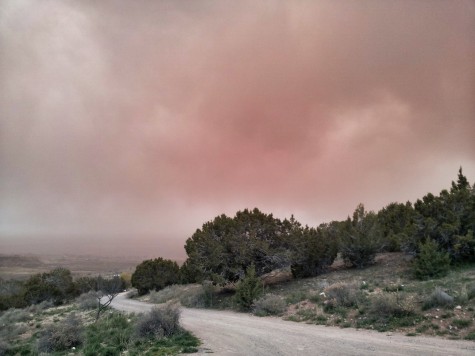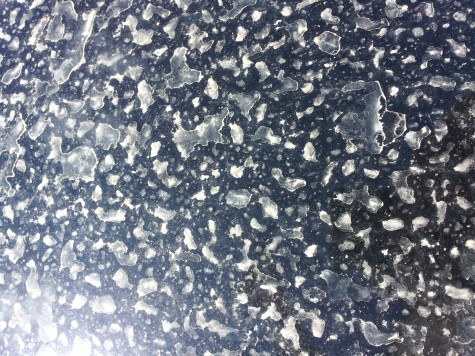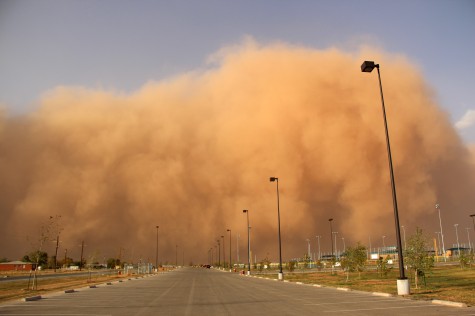
Photo: Craig Childs
Unusual dust storms have been rolling out of the Southwest and flying across where I live in Colorado, a state that doesn’t appreciate brown or red in its snow. These storms are vectors of change, fingers of desertification creeping up into better-watered country.
I’ve lived near the upper ends of the Gunnison River in Western Colorado since 1990, a brief and anecdotal period, but long enough to notice the last several years bringing dust storms in frequency and intensity I’d never before witnessed. I used to see them a time or two every few years, red-boiling clouds and gusting winds, but now these powerful, apocalyptic-looking storms are coming from 4 to 8 times every spring, blanketing the state, riding each other’s tails like horsemen out of Utah.
They come in March and April mostly. The winds are west by southwest. The source of the increasing sediment is a combination of factors: road work, mining, grazing, mountain biking, and the countless rooster-tails of 4 X 4s on back roads. The cause is equally drought, reservoir reduction, and orders of magnitude more oil and gas roads. To whittle it down to the most evident cause: human activity. The biggest cause may be anthropogenic climate change and the reduction of vegetative cover. We are, in other words, kicking up a lot of dust.
However many factors are at play, one fact remains: more fine sediment is being produced and transported out of the Southwest than in recent memory.
We always had spring winds and good storms. The big rivers, the Green and the Colorado, sometimes looked like they were flowing upstream. Low clouds skidded past, skies around them often clear as a bell. Now the storms come red, sun blaring like a spotlight through tomato soup. When it rains, windshield wipers are slapping blood. Ski runs turn dirty. Your car dries covered with what looks like running, brown-red mascara.

Standing in the middle of one of these storms feels like you are taking geomorphology in the teeth. Arid landscapes are experiencing an eolian mass wasting and you are watching it happen.
Though sediments are flying as far as Wisconsin and the East Coast, dispersal into Colorado is enough for snow-white mountains to turn a menstrual pink. The color absorbs solar radiation. Snow warms up and begins to melt earlier in the season, sending the annual snow pack into a torrent. One study found dust cover in the San Juan Mountains in southwest Colorado to be responsible for melting snows 18 to 35 days earlier than without the dust. Another predictive model shows dust-loading putting peak runoff for the Colorado River 3 weeks earlier than average, causing the river to flow around 5% less than annual average because of plants in the mountains exposed earlier in the year.
This spring, backcountry skiers in Colorado are reporting sun-cupping a month earlier than last year, and a general brown or redness to the snow. Near the end of April, snow under the discoloration has begun melting at an accelerated rate. If this phenomenon persists, it is the definition of a regime change, a toggle flipped on a global switchboard, which the IPCC points out, is switching fast.
I’ve been watching these storms year after year from semi-arid, well-irrigated hills and mesas below the West Elk Mountains in western Colorado, orchard country, vineyards and vegetable farms. The irrigation water this year will probably run out a month earlier than usual because of the storms, headgates closing in July instead of August, which used to be August instead of September. A trend does stand out. Even if we get a good snow pack, as we have this year, it will be used up before everyone at the upper end has the water they need.
Should we panic? When picking up a box of vegetables from one small farm or another, the talk is generally about schools and snow pack. The storms? They don’t get much mention. No one’s pulling their hair out over them. Lower Basin States are going to get most of the water they are demanding, at least for now. They’ll just get it a month earlier, something we’re having to get used to.
Stand with these farmers in their fields and orchards, their fingers digging through buds to see how much of the crop survived cold or wind, and they say it’s always been tenuous, you have to adapt. The storms? You deal with them.
But they will mention the storms differently if you sit over a beer. Direct irrigation, as in not from reservoirs, is off in September, then August, then July; the last couple decades seem to be pointing somewhere other than stability. This may be one of those dips you’d see on a chart of climatic fluctuations, only that chart might be of the wobble before the crash, the wavering before a jump. Those I’ve talked with at length say they know what soil should look like, and they can see a day when these semi-arid, irrigation-dependent farms and fields shrink, arable land replaced with salt-crusted fields and piped-out irrigation water meeting downstream demands. They wonder about an end: a yet bigger switch being thrown, ground turning to dust.

I spent some time growing up around Phoenix, Arizona, a place justly categorized not as semi-arid, but completely arid. We had haboobs, an Arabic word for intense dust storms, practical walls of billowing sediment better known for rolling across the Sahara and the Arabian Peninsula. Haboob is now being picked up as a term by people living in Southern California, Arizona, New Mexico, Mexico and Texas, as the frequency of them increases.
Living around there, I used to hear about what was called Valley Fever, a fungal infection you got from breathing in the brown-yellow dust of a haboob. Last year, a study by the Centers for Disease Control and Prevention found a dramatic increase in Valley Fever from 1998 through 2011 in Arizona, California, Nevada, New Mexico and Utah. Cases went from 2,265 to 22,000, and this year so far has seen almost double the five-year median of reported cases.
This is one of the ways deserts move. They enter you, hard on living things, reaching down your throat and into your lungs.
Another way deserts move is by picking up and flying through the air, dusting snow up high and sending melt-waters down early, snow pack depleted before the end of summer. I live at edge of the West Elk Mountains facing into Utah, where the dust landing on us is coarser than farther south. It covers a cooler terrain than the haboobs, not the right habitat for the fungus Coccidioides, which causes Valley Fever.
This is a global condition, not just local to Western Colorado or the Southwest. Desertification stretches the arid boundaries of the world. If you live in or anywhere near a region classified as semi-arid, take note. Semi-arid climate is a global belt that surrounds most of the world’s active deserts. Never mind the IPCC report if it bothers you. You can discount as hysterical the rantings of those who demand solutions. Throw it all away if you like, but consider this one thing. I live in Western Colorado where storms have been boiling like blood, with a frequency and severity we’ve not seen in recent time. The snows are melting before they can finish feeding our farms. This can’t be a good thing.
Wonderful article. Thank you for tying together the freaky and yet kind of cool dust storms with two other nasty side effects – earlier snowmelt and Valley Fever. I’d only learned about the latter from another recent article in the New Yorker, about dust storms in general (http://www.newyorker.com/reporting/2014/01/20/140120fa_fact_goodyear?currentPage=all). I have a feeling we’ll be hearing a crapload more about that “little” condition in the next few years.